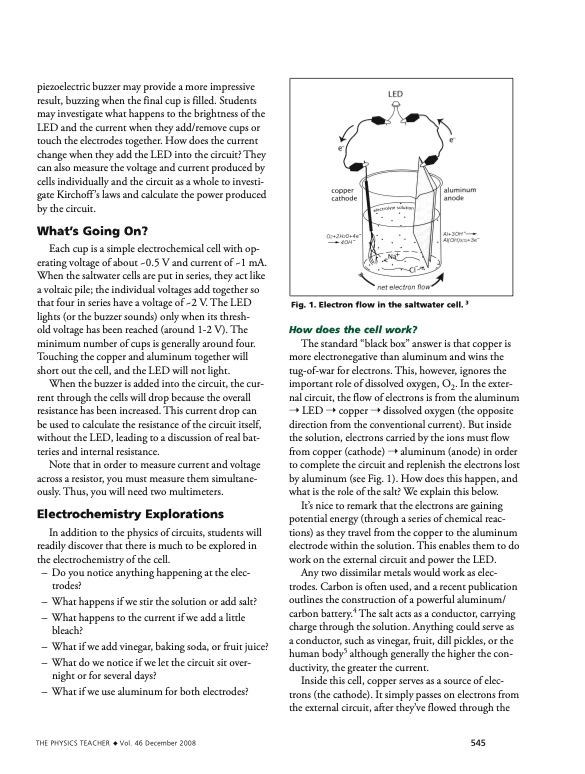
PDF Publication Title:
Text from PDF Page: 002
piezoelectric buzzer may provide a more impressive result, buzzing when the final cup is filled. Students may investigate what happens to the brightness of the LED and the current when they add/remove cups or touch the electrodes together. How does the current change when they add the LED into the circuit? They can also measure the voltage and current produced by cells individually and the circuit as a whole to investi- gate Kirchoff ’s laws and calculate the power produced by the circuit. What’s Going On? Each cup is a simple electrochemical cell with op- erating voltage of about ~0.5 V and current of ~1 mA. When the saltwater cells are put in series, they act like a voltaic pile; the individual voltages add together so that four in series have a voltage of ~2 V. The LED lights (or the buzzer sounds) only when its thresh- old voltage has been reached (around 1-2 V). The minimum number of cups is generally around four. Touching the copper and aluminum together will short out the cell, and the LED will not light. When the buzzer is added into the circuit, the cur- rent through the cells will drop because the overall resistance has been increased. This current drop can be used to calculate the resistance of the circuit itself, without the LED, leading to a discussion of real bat- teries and internal resistance. Note that in order to measure current and voltage across a resistor, you must measure them simultane- ously. Thus, you will need two multimeters. Electrochemistry Explorations In addition to the physics of circuits, students will readily discover that there is much to be explored in the electrochemistry of the cell. – Do you notice anything happening at the elec- trodes? – What happens if we stir the solution or add salt? – What happens to the current if we add a little bleach? – What if we add vinegar, baking soda, or fruit juice? – What do we notice if we let the circuit sit over- night or for several days? – What if we use aluminum for both electrodes? THE PHYSICS TEACHER � Vol. 46 December 2008 545 Fig. 1. Electron flow in the saltwater cell. 3 How does the cell work? The standard “black box” answer is that copper is more electronegative than aluminum and wins the tug-of-war for electrons. This, however, ignores the important role of dissolved oxygen, O2. In the exter- nal circuit, the flow of electrons is from the aluminum � LED � copper � dissolved oxygen (the opposite direction from the conventional current). But inside the solution, electrons carried by the ions must flow from copper (cathode) � aluminum (anode) in order to complete the circuit and replenish the electrons lost by aluminum (see Fig. 1). How does this happen, and what is the role of the salt? We explain this below. It’s nice to remark that the electrons are gaining potential energy (through a series of chemical reac- tions) as they travel from the copper to the aluminum electrode within the solution. This enables them to do work on the external circuit and power the LED. Any two dissimilar metals would work as elec- trodes. Carbon is often used, and a recent publication outlines the construction of a powerful aluminum/ carbon battery.4 The salt acts as a conductor, carrying charge through the solution. Anything could serve as a conductor, such as vinegar, fruit, dill pickles, or the human body5 although generally the higher the con- ductivity, the greater the current. Inside this cell, copper serves as a source of elec- trons (the cathode). It simply passes on electrons from the external circuit, after they’ve flowed through thePDF Image | Salty Science of the Aluminum-Air Battery

PDF Search Title:
Salty Science of the Aluminum-Air BatteryOriginal File Name Searched:
TPT_Salty_Science.pdfDIY PDF Search: Google It | Yahoo | Bing
Product and Development Focus for Salgenx
Redox Flow Battery Technology: With the advent of the new USA tax credits for producing and selling batteries ($35/kW) we are focussing on a simple flow battery using shipping containers as the modular electrolyte storage units with tax credits up to $140,000 per system. Our main focus is on the salt battery. This battery can be used for both thermal and electrical storage applications. We call it the Cogeneration Battery or Cogen Battery. One project is converting salt (brine) based water conditioners to simultaneously produce power. In addition, there are many opportunities to extract Lithium from brine (salt lakes, groundwater, and producer water).Salt water or brine are huge sources for lithium. Most of the worlds lithium is acquired from a brine source. It's even in seawater in a low concentration. Brine is also a byproduct of huge powerplants, which can now use that as an electrolyte and a huge flow battery (which allows storage at the source).We welcome any business and equipment inquiries, as well as licensing our flow battery manufacturing.| CONTACT TEL: 608-238-6001 Email: greg@salgenx.com | RSS | AMP |